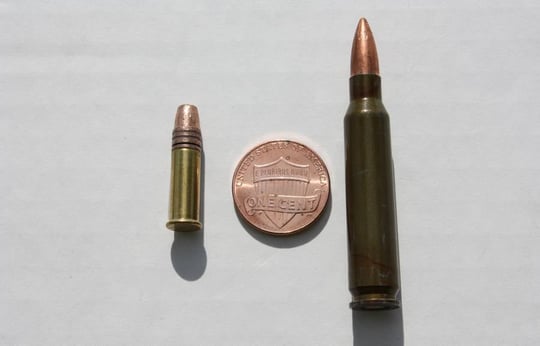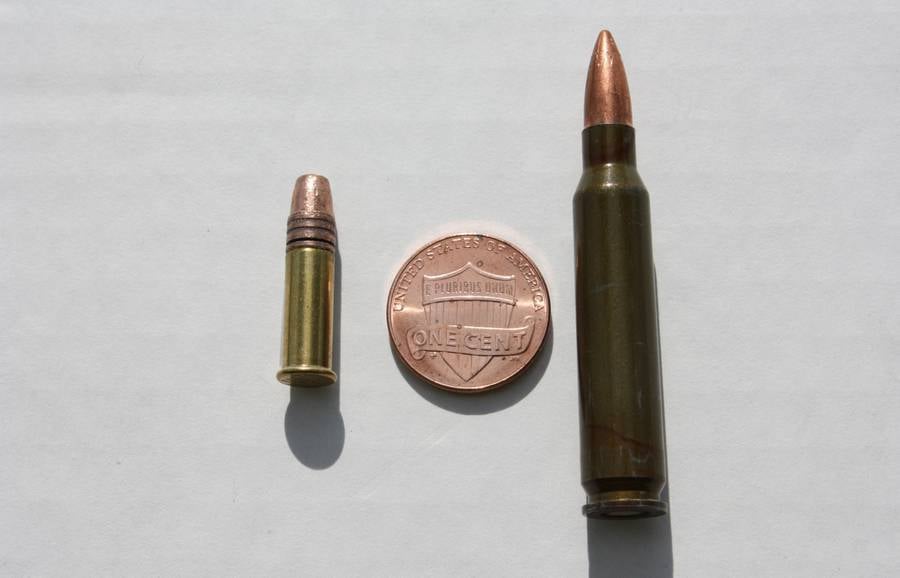As we mentioned in our last post, the powerful, accurate .223 has quickly become one of the most popular rifle cartridges in America–which also makes it a growing concern for anyone interested in bullet proof security. Unfortunately, the most common consumer-grade bullet proof windows simply cannot match the penetrating power of the .223.
A Brief Review on the .223
The .223 is the consumer version of the military’s 5.56 ammunition used in M16 assault rifles (which are in turn based on the Colt AR-15 semi-automatic rifle, and have become the model for modern sporting rifles). The projectile of the .223 has dimensions similar to that of the common .22 rifle cartridge (which are often used for teaching, target practice, “plinking,” and hunting very small game like squirrels, rabbits, and pest rodents). Both are shown in the image below (with the a .22LR on the left and the .223 on the right).

What you’ll immediately note is that although the bullets (that’s the top of the cartridge, the actual projectile) have similar dimensions, the .223 is clearly much more aerodynamic (and can be a bit heavier: .22s commonly range between two and three grams, while .223s can be as heavy as five grams).
The major differences is in the load: The much larger casing of the .223 allows for much more gunpowder to propel the bullet. Consequently, a .223 bullet travels up to three times faster than the .22 bullet–it’s one of the fastest bullets available to the public–and strikes nearly ten times harder.
The combination of a small, aerodynamic projectile moving incredibly fast makes the .223 especially hard to stop with standard bullet proof windows.

.223 Bullet Resistant Windows
Most bullet resistant windows currently installed in liquor stores and banks use monolithic acrylic. At around 1.25 inches, solid acrylic will easily stop several rounds from 9mm, .357, or .44 Magnum pistols. These rounds (shown in the picture below) are most often “semi wadcutters”: Snub-nosed projectiles designed to pancake, and thus efficiently transfer their momentum to their target for maximum stopping power at close range.
Acrylic bullet resistant glass takes advantage of this design: the bullet pancakes on the hard surface of the acrylic, and its momentum is gobbled up quickly as it smashes a handful of chips off the surface.
But the physics of a .223 is significantly different form that of a semi wadcutter; the .223 is slim, sharp, and moving fast–it’s designed to pop right through a barrier, even an acrylic bullet proof window.
Defending against the .223 calls for an entirely different approach. Not only must the ballistic glass be thicker–at least 1.625-inches thick, if not 1.75–it also needs to be of an entirely different composition. The only bullet resistant glass that’s going to stop a .223 is glass-clad polycarbonate. This laminated ballistic transparency is made by stacking layers of tempered glass and polycarbonate–a thermoplastic similar to acrylic, but softer and more pliable–interleaved with thin layers of epoxy.
When a .223 strikes a window made of glass-clad polycarbonate, the outer surface of tempered glass forces the projectile to partially pancake, spoiling its aerodynamic design. That tempered glass then shatters, and the inner layers of epoxy and polycarbonate flex like a backstop. Because this material is softer and denser than bullet resistant glass or acrylic, it often swallows the bullet up and holds it. While an acrylic-based bullet resistant window is unlikely to stop even a single .223, a rated Level 7 system using glass-clad polycarbonate ballistic glass will easily catch a burst of five or more of these bullets.
But a bullet resistant window isn’t just a hunk of glass-clad polycarbonate. In order to actually keep people safe, these windows need to be mounted in true ballistic framings, not 14 gauge steel–which the .223 round was designed to penetrate–or the fiberglass “packed” frames some bullet proof companies use to hold down costs. Bullet proofing experts like Total Security Solutions CEO Jim Richards always advise that their high-level bullet resistant windows be mounted in a specialized UL-rated bullet proof aluminum frame backed with internally integrated strips of ballistic fiberglass.
Next Steps
- Join our mailing list
- Download our Complete Guide to Bulletproof Glass and Bullet Resistant Barriers

